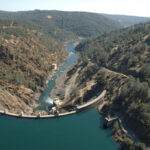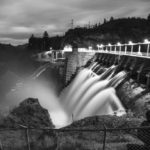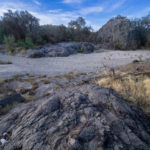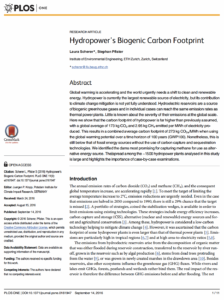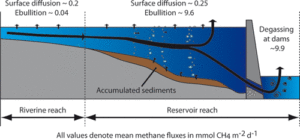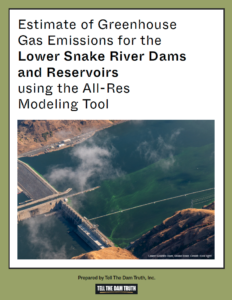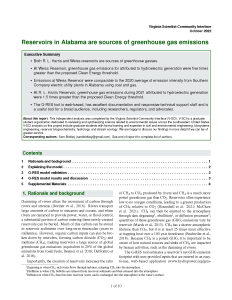Reservoir Emissions
The science is clear
Hydropower reservoirs can produce significant amounts of methane and other potent greenhouse gases, sometimes even on par with coal and natural gas facilities. While there is increasing recognition of this reality, emissions at hydro facilities are still under-analyzed and under-reported. We need widespread assessment of emissions at hydro facilities across the country and policies that ensure hydro is treated appropriately as we decarbonize our power grid.
FAQs
How does a hydropower project produce GHG emissions?
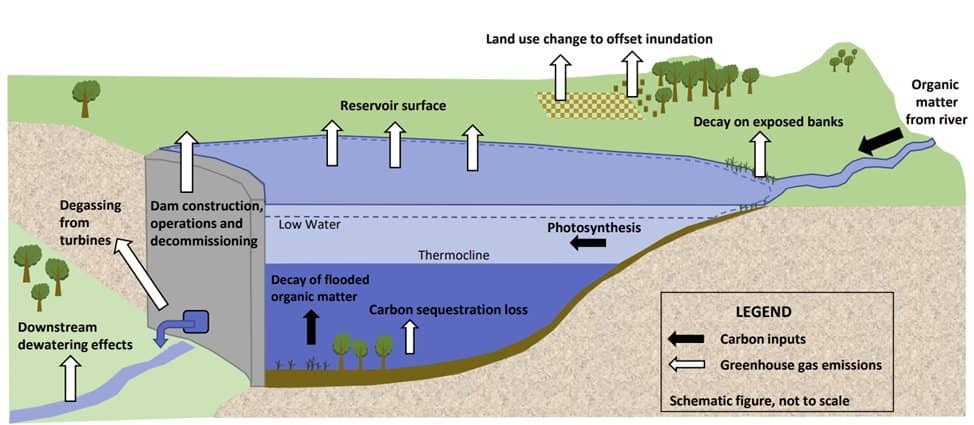
Pathways of GHG emissions in a dam and reservoir system | TellTheDamTruth.com
How is a hydro facility different from a non-powered reservoir?
Water levels at a hydropower reservoir fluctuate much more dramatically than you typically see at a non-powered reservoir because the water is released through the turbines according to the demands of the energy market and the grid. These fluctuating water levels lead to increased emissions as methane bubbles up from lower depths instead of being weighed down by more water, and also produce emissions through decaying plants on exposed banks. The operations themselves have a big impact on the amount of methane emitted at a hydro facility.
What can be done to mitigate emissions?
A lot. Operational changes can make a big difference. These include adding water intakes from upper levels to mitigate degassing, adjusting flow regimens to control water levels and reduce emissions from shoreline drawdown areas, increasing dissolved oxygen levels to help regulate methane production, and more.
How does methane compare to carbon dioxide?
Methane is a hydrocarbon with the chemical formula CH4, whereas carbon dioxide is CO2. Both methane and carbon dioxide emissions contribute to climate change. In fact, methane is 25% more harmful than carbon dioxide when it comes to climate change, because it is more efficient at trapping heat in the atmosphere.
Does that mean hydropower is not carbon-free?
What can we do about this?
GHG emissions at hydro facilities are under-analyzed and under-reported. For the vast majority of hydropower projects, we have little idea how much methane they are emitting and what damage that is causing to the climate. Emissions assessments should be standard practice during licensing proceedings, so that appropriate emission mitigation conditions can be included in a new license.
Multiple tools exist to estimate the emissions from a hydro project.
Power companies also need to take responsibility for their projects and the emissions they produce. They should know how much their projects are emitting so they can implement changes to mitigate those emissions.
What next?
Globally, there is increasing recognition of this issue. The U.S. included reservoir emissions in its report to the International Panel on Climate Change for the first time in 2022. This is an important milestone, but hydro’s contribution to national GHG emissions was undercounted because most reservoirs have not been assessed.
Policymakers and regulators must require monitoring, reporting, and mitigation of methane and other GHGs. For too long, hydro has been seen as a clean energy source and a solution to the climate crisis.
We also know that changes to how a hydropower facility is designed and operated can make a big difference when it comes to emissions. Any hydro that is part of a clean energy grid must be operated responsibly.
Here’s how we can improve things:
- Support additional research into greenhouse gas emissions at reservoirs and hydropower generation facilities, including methodologies for quantifying emissions and opportunities for mitigation of emissions through improved reservoir operations.
- Ensure that federal, state, and local agencies are properly accounting for the greenhouse gas emissions of hydropower operations as part of their climate goals.
- Encourage the Environmental Protection Agency to add reservoirs, including hydropower projects and their operations, to the Greenhouse Gas Reporting Program.
- Oppose and prevent the construction of new dams, diversions, and reservoirs, not just for their impacts on rivers, but also as the potential largest source of new greenhouse gas emissions from the hydropower sector that can be avoided entirely.
- Ensure that Climate Action Plans and related programs that provide incentives for a transition to net zero emissions by 2050 accurately reflect the greenhouse gas emissions from hydropower projects and their impacts on rivers.
- Inform the FERC hydropower licensing process by requiring that National Environmental Policy Act project reviews include a greenhouse gas emissions analysis for each project. For pumped storage projects, this analysis should be expanded to include the source of energy used for pumping.
- Encourage FERC to consider project emissions in their decision-making during the licensing process for existing dams, new dams, and projects that retrofit unpowered dams with hydropower.
- Address greenhouse gas impacts in a cumulative, life cycle and watershed-wide planning approach whenever possible.
Learn more
Factsheet: Hydropower Dams Across the U.S. are Leaking Methane

Hear from our membersMore news
| From Hydropower Reform Coalition 6/18/2024 |
|
From South Yuba River Citizens League 10/2/2023
Challenging the Hydropower Clean Energy Future Act: SYRCL’s Perspective |
|
From Alabama Rivers Alliance 10/28/2022
BREAKING: Recent Report Shows hydropower Reservoirs in Alabama Emit *Substantial* Amounts of Methane |
| From American Rivers 8/16/2022 |
| From American Rivers 2/28/2022 |
Academic articlesMore resources
| Academic Articles / Reservoir Emissions 9/14/2016 |
|
Academic Articles / Reservoir Emissions 6/15/2013
Sediment Trapping by Dams Creates Methane Emission Hot Spots |
More from our Resource LibraryMore resources
| Reports / Reservoir Emissions 3/18/2024 |
|
Reports / Reservoir Emissions 10/1/2022
Report: Reservoirs in Alabama are Sources of Greenhouse Gas Emissions |


